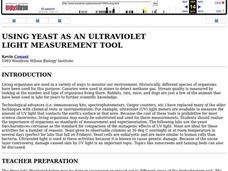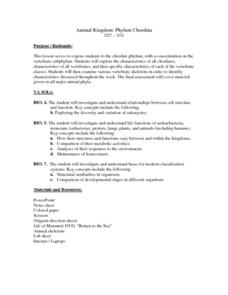Curated OER
Algae Experiments
Students describe the characteristics of algae. In this biology lesson, students perform a series of experiment to explore algae. They investigate the basic things algae need to survive.
Curated OER
Chloroplasts
Students study chloroplasts, their structure and evolution. In this photosynthesis instructional activity students experiment with polarized light and the production of chlorophyll.
Curated OER
DNA: The Search for the Genetic Material
Young scholars study the history of DNA and how to extract it. For this genetic lesson students complete a DNA experiment using bacteria.
Curated OER
How Genes Work Lesson Plan
High schoolers define the key terms that are the structure and function of DNA. In this genetics lesson students complete a lab activity in which they construct a model DNA structure.
Curated OER
BIoluminescence
Students investigate the concept of bioluminescence. They use dinoflagellates in a lab situation to study photosynthesis. They conduct research into the concept using a variety of resources. Also the class is taken on a field trip to...
Curated OER
Species Diversity and Phylogeny
Students explore the classification system of organisms: taxonomy. They examine prepared slides of Protozoans and record information on a Taxonomy Recording Sheet. Two additional classifying activities are also included in this lesson.
Curated OER
The Effects of Ultra-Violet Light on Yeast
Pupils work in small groups collecting and analyzing data as they learn how to best grow yeast. This lesson plan allows students to conduct several student-created experiments as they continually generate questions and hypotheses. ...
Curated OER
Lights On - We Have A Quorum
Young scholars explore basic bacteriological techniques. They investigate cell to cell communication and become aware of the environmental and evolutionary implications of this communication.
Curated OER
Using Yeast as an Ultraviolet Light Measurement Tool
High schoolers accurately measure the relationship between radiation dose and either survival or some genetic event such as mutation or recombination. They investigate the damage that was done to the DNA molecule as a result of exposure...
Curated OER
Animal Kingdom: Phylum Chordata
Learners use a dichotomous key to classify various vertebrate jar speciments into classes. They examine the speciments for general characteristics of each class and fill in a corresponding chart and then complete a few final assessment...
Curated OER
Invertebrate Classification
Young scholars discuss the recent disovery of the "furry lobster" to peak interest in the animal kingdom. They classify various speciments using invertebrate dichotomous keys, identifying major animal phyla and classes. Thy the complete...
Curated OER
The Human Cheek Cell
Students list the parts of cell theory and describe and define vocabulary. In this cell lesson students complete a handout that includes sketching a cell.
Curated OER
Cell Structure and Function
Learners compare the organelles present in plant and animal cells. In this biology lesson, students create an analogy to easily remember their assigned organelles. They also research their function and write a creative story.
TeachEngineering
Teach Engineering: Cell Celebration!
Students look at the components of cells and their functions. The lesson focuses on the difference between prokaryotic and eukaryotic cells. Each part of the cell performs a specific function that is vital for the cell's survival....
Other
University of Cincinnati: Project Step: Antibiotics
STEM biology instructional activity where by designing their own antibiotics, students will gain an understanding of how the differences between prokaryotic cells and eukaryotic cells have played a role in their own health. They will...
Alabama Learning Exchange
Alex: Building a Cell: Edible Cell Project
Students will create an Eukaryotic cell from materials that they can eat. Students will need to have a lesson on the types of Eukaryotic cells and its organelles before they complete this assignment. Students will construct these...
Alabama Learning Exchange
Alex: Inside the Cell
In this lesson, students learn the different kinds of cells including plant and animal cells. They also learn how to identify and name the organelles of eukaryotic cells.
Alabama Learning Exchange
Alex: Cells
Middle schoolers will research prokaryotic and eukaryotic cells. The students will then research plant and animal cells, comparing and contrasting the two. Middle schoolers will also research the major organelles and the function of...
Alabama Learning Exchange
Alex: What's in a Cell?
This lesson focuses on the function of organelles through technology integration. The students will identify the various organelles by using an electronic game. Then, they will construct a Prezi (online presentation) and present their...
Science Education Resource Center at Carleton College
Serc: Observe, Describe, Compare and Contrast Cells
This investigation allows students to observe cells from multiple sources. Plant, animal and bacterial cells will be observed as well as cells from multicellular organisms and single-celled organisms. After providing written descriptions...
Alabama Learning Exchange
Alex: Cells! Cells! Cells!
Young scholars will learn about both POP Art and science in this pattern project. Working in conjunction with a science teacher in your school, students will view cells through a microscope and use visual diaries to create pattern...
Other popular searches
- Prokaryotes and Eukaryotes
- Prokaryotes vs Eukaryotes
- Prokaryotes vs. Eukaryotes
- Prokaryotes Eukaryotes
- Gene Expression Eukaryotes
- Eukaryotes Verses Prokaryote
- Cells Eukaryotes
- Origrn of Eukaryotes
- The Function Eukaryotes
- Function Eukaryotes
- Eukaryotes Poems




















